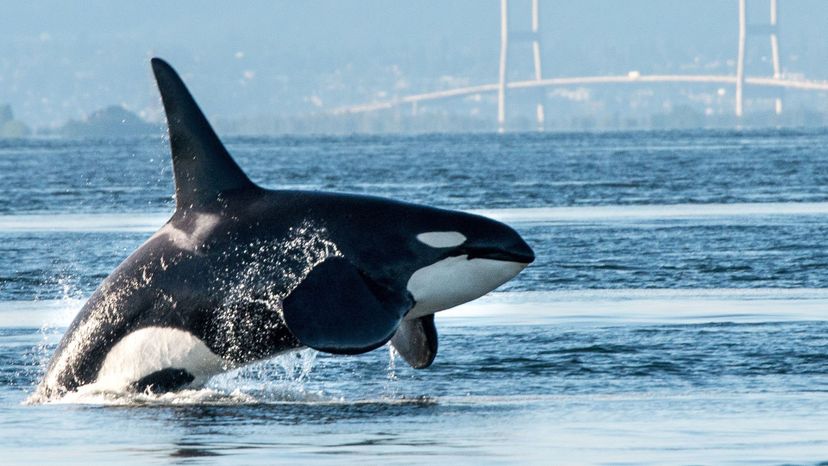
About This Quiz
There's a lot to ooh and ahh over in the vast oceans and seas of the world, but possibly the most majestic of all animals is the whale. Whales belong to the order "Cetacea,†and along with other members of this group like dolphins and porpoises, they are mammals who are totally accustomed to aquatic environments. Unlike many other sea creatures, however, whales need air to survive and have to surface regularly, which is why they don't sleep for very long.
Unfortunately, not everyone has historically respected the critical part that whales play in the ecosystem, so they've been hunted and otherwise affected to near extinction. They're currently listed as endangered, with some species completely wiped out already. In fact, one of the most threatened right now is the North American right whale, of which there are only about 300 left in the world. Aside from the fact that the world would be a less incredible place without whales, their status at the top of the food chain means that there are very real dangers to the rest of the marine environment, should they be totally eradicated. Even though protective measures have been taken for decades now in an effort to reverse the effects of whaling, six of the 13 "great†whale species are listed as endangered.
Although there are plenty of differences between the various species of whale, each one is impressive in its own right. Can you tell one type of whale from another? Take our quiz to see how much you know about whale species and how these creatures differ.
At least 70 different species make up the order Cetacea, which includes dolphins and whales.
While some whale species are endangered - there are just a few hundred baiji and vaquita whales, for instance - others, like the killer whale, are not endangered or threatened.
Whales fall into one of two groups: the odontocetes, or toothed whales, and the baleen, or nontoothed species.
Advertisement
The sperm whale reigns supreme as the largest of the odontocetes.
The sperm whale is known for its giant head, which generally represents about one-third of the creature's entire body.
The sperm whale may have a massive brain, but when you compare it to the size of the animal's head and body, the brain is roughly proportional compared to that of other animals.
Advertisement
Thanks to its whistles, squeals and clicks, the beluga whale is often called the canary of the sea.
The massive gray whale, which can grow as long as 50 feet (15 meters), prefers to dine on krill and other surface creatures on the seabed.
Unlike other whales, the beluga whale has a nonfused neck, which allows the creature to turn its head from side to side and nod.
Advertisement
The beluga whale gets its name from the Russian word "bielo," which means white.
Weighing as much as 24 elephants, the blue whale is the largest animal to ever inhabit Earth.
Despite its massive size, the blue whale is a baleen and prefers to eat krill and plankton.
Advertisement
Prior to the whaling industry of the early 20th century, blue whales numbered over 200,000. Today, only an estimated 5,000 remain.
The humpback has a large pectoral fin, which can measure up to 15 feet (5 meters) and allows the creature to swim in all directions, even backward.
The humpback is toothless, which makes it a baleen.
Advertisement
The honor of farthest average migration goes to the humpback, which can travel over 5,000 miles (8,000 kilometers) in search of warmer climates as the seasons change.
The killer whale, or Orcinus orca, is not only the largest member of the dolphin family, but also exhibits the same social behavior that dolphins are famous for.
Killer whales are black with a white belly - think Shamu.
Advertisement
The bowhead whale has a dark body with a distinct white chin and also notably lacks a dorsal fin.
The bowhead makes its home in the Arctic Ocean, relying on its blubber, which can be over 18 inches (46 centimeters) thick, to stay warm.
Between 30 and 40 percent of the bowhead whale's length comes from its thick skull, which the creature uses to break through ice.
Advertisement
The fin whale is the second largest whale species after the blue whale. These two species are capable of interbreeding to create hybrid animals that share traits of both species.
Fin whales can grow up to 85 feet in length and tend to be larger in the Southern Hemisphere than they are in the Northern.
There are approximately 13 species of baleen whale, including the blue whale, fin whale and the sei.
Advertisement
There are roughly 70 species of toothed whales, including the sperm whale, the beluga and the pilot whale.
There are around 22 species of beaked whale with dolphinlike snouts, including a new species discovered in 2014.
Even the smallest baleen whale, the minke, can grow as long as 35 feet (11 meters) and weigh as much as 20,000 pounds (9,000 kilograms).
Advertisement
Narwhals, a whale species known as the unicorn of the sea, is known for its long tusk, which can grow as long as 10 feet (3 meters).
Unlike many other whale species, narwhals don't migrate. Instead, they make their homes in the arctic waters of Canada, Greenland and Russia.
That tusklike appendage is actually a giant tooth with more than 10 million nerve endings, allowing the creature to detect everything from temperature changes to the salinity of the water.
Advertisement